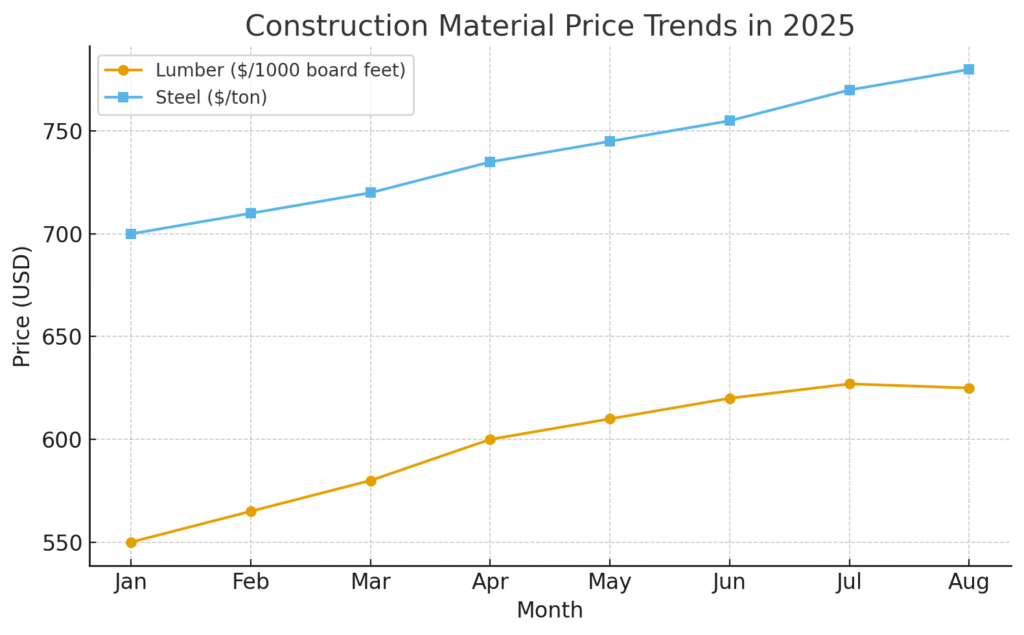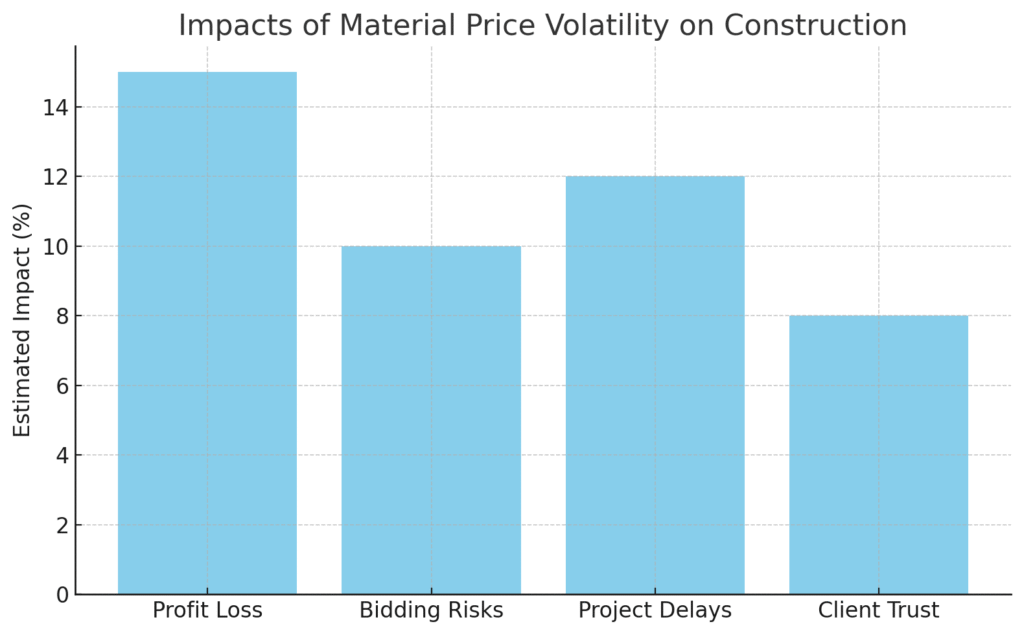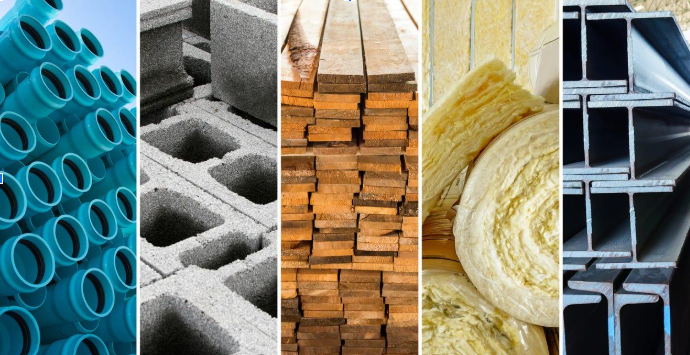Building projects like homes or big commercial structures face a big challenge of the prices of materials. The prices of materials like lumber, steel, and concrete keep on changing. Planning a project with a set budget can be hard to go smoothly when the cost of materials has gone up. This is a real problem in 2025, with construction costs rising by about 6% in the first half of the year. As experts in creating accurate construction estimates, we know how these price swings can affect projects. In this article, we’ll explain why material prices change, how they affect your work, and what you can do to keep your projects on budget. Our goal is to help you turn these challenges into opportunities to win more clients.
Why Material Prices Keep Changing
Material prices don’t just change for no reason. Several clear factors make them go up and down, and understanding these can help you plan better.
- Tariffs and Trade Rules: New government rules, like tariffs, can make materials more expensive. For example, about one-third of construction materials might cost more because of new trade policies in 2025. Steel prices like rebar are expected to go up by 4.9% this year, dropping a bit in 2026.
- Supply Chain Issues: Global trade issues or natural disasters can make it hard to get materials. For instance, copper pipe prices have jumped over 40% this year and copper wire is up 14-17% since January. These shortages affect things like plumbing and electrical work.
- High Demand and Inflation: There’s a lot of construction happening, spending reached $2,139.1 billion in July 2025. This high demand pushes prices up. Concrete prices for example, are up 1.2% this year because cement and gravel cost more. Overall, building materials rose 0.8% from February to March 2025.
- Specific Material Costs: Lumber and steel are especially unpredictable. Lumber prices might hit $627.26 by the third quarter of 2025 and steel prices are climbing too, adding to a 0.3% monthly increase in material costs in August.
Having the knowledge of these reasons let you prepare for price changes and avoid budget overruns in your projects.

How Construction Material Price Volatility Affects Estimates
When material prices increase, even the best plans can go wrong. Here’s how these changes can affect your work and why they matter.
- Higher Costs Eat Profits: Rising material prices have made building more expensive. For example, the cost to build a new home now makes up 64.4% of its price, up from 60.8% in 2022. In 2025, nonresidential projects might see a 4.4% cost increase, and homes could go up by 5%. Without planning for this, you could lose 10-15% of your profits.
- Bidding Becomes Risky: When you bid on a job, you want to win it, but low bids can backfire if prices rise later. Steel and lumber costs can change by 10% or more. This makes it hard to offer affordable roofing estimates for contractors without losing money.
- Delays and Money Shortage: Sudden price change can force you to renegotiate with clients or find cheaper materials, slowing down projects. This is a big issue for things like roads and bridges where costs are a top concern.
- Losing Client Trust: Clients want projects done on time and on budget. If prices keep changing, they might lose faith in you, which can lead to future business losses.
These problems hit your wallet and your reputation. Using strategies like affordable construction estimating services for volatile markets in the USA can help you stay in control.

How to Protect Your Projects from Price Changes
You don’t have to let price swings ruin your projects. Here are simple, effective ways to stay ahead.
- Use Up-to-Date Data: Tools that track current prices, like 2025 reports showing steady but risky growth, help you make accurate bids. This keeps your estimates realistic.
- Add Safety Nets in Contracts: Include clauses that adjust for price increases, especially for projects lasting a long time. With material costs expected to rise 5-7% in 2025, this protects your profits.
- Work with Multiple Suppliers: Don’t rely on one source for materials. Having options helps you avoid delays and price spikes, as 2025 reports warn about supply issues.
- Get Expert Help: Professional estimating services, update your plans every quarter and prepare for different scenarios. This is key for managing construction material price volatility and keeping estimates affordable.
Don’t wait for the next price jump to act. Get a free consultation now to update your estimates before new tariffs hit in! Contact ALM estimating now.
How Outsourcing Estimating Services Help in Volatile Markets
Construction projects have the challenges of unexpected changing prices of materials like lumber and steel. These price shifts can cause budget overruns, kill profits, and delays in projects. Outsourcing your estimating to pros is a smart way to stay ahead of these issues. Expert firms use real-time data and proven methods to create accurate estimates, keeping your bids competitive and your projects on track. Here’s why outsourcing is a game-changer for handling construction material price volatility.
- Access to Real Time Price Data: Outsourcing expert estimators use advanced tools and current reports to track material costs and its expected changes like the 4.9% rise in steel rebar prices. This means your bids are competitive and follows the latest market trends, avoiding extra costs.
- Reduce Risks in Bidding: Experts follow market ups and downs, ensuring you don’t underbid and lose money or overbid and miss jobs. With construction costs up 6% this year, their insights protect your margins.
- Saves time: Tracking prices for materials like copper take hours. Outsourcing construction estimating services lets you and your team focus on building projects. While estimators handle the numbers.
- Client Trust: Accurate estimates, even when prices are not stable, outsourcing let you build clients’ trust. This boosts your confidence and strengthens your relationships.
- Affordable Expertise: Hiring a full time estimating team can be expensive. Firms like ALM Estimating offer cost-effective services, giving you expert help without breaking the bank.
Don’t let price swings derail your projects. Book a free consultation with ALM Estimating today to secure accurate, market-ready estimates.
Conclusion: Turning Material Price Volatility into Opportunity
Construction material price volatility is one of the biggest challenges contractors are facing in 2025. Prices for lumber, steel, and concrete continue to rise and fall creating risks for budgets and timelines. Without a well-prepared plan, projects can lose profit, client trust and face delays. These risks can be managed. Through outsourcing services who use real-time data, adding safety clauses in contracts, working with multiple suppliers, and outsourcing estimating services, contractors can stay ahead. Outsourcing construction Estimating services offer accurate, affordable estimates that help you win bids and protect margins. Using the right strategies, you can turn material price changes into an opportunity to grow and succeed in competitive markets.
Act fast! Get a discount of 30% today to lock in accurate estimates or grab our free guide on handling rising construction costs.
For the ultimate edge, request a custom volatility audit now. Spots are limited as 2025 gets busier. Let ALM estimating help you turn price swings into successful projects. Contact us now.
FAQs:
1. What is material price volatility in construction?
It means the cost of materials like steel, lumber, and concrete changes often. These sudden shifts can make it hard for contractors to stick to budgets.
2. Why are construction material prices rising in 2025?
Tariffs, supply chain disruptions, and high demand are the main causes. Reports show construction costs have already risen about 6% this year.
3. How does volatility affect construction estimates?
Unstable prices increase risks in bidding. Contractors may lose profits if costs rise after bidding too low or lose jobs by bidding too high.
4. How do contractors manage rising material costs?
Using current data, adding contract clauses for price changes, sourcing from multiple suppliers, and outsourcing estimating services are key strategies.
5. Why outsource estimating services to ALM Estimating?
ALM Estimating offers accurate, affordable estimates built on real-time data. This helps contractors protect profits and win more projects in volatile markets.
